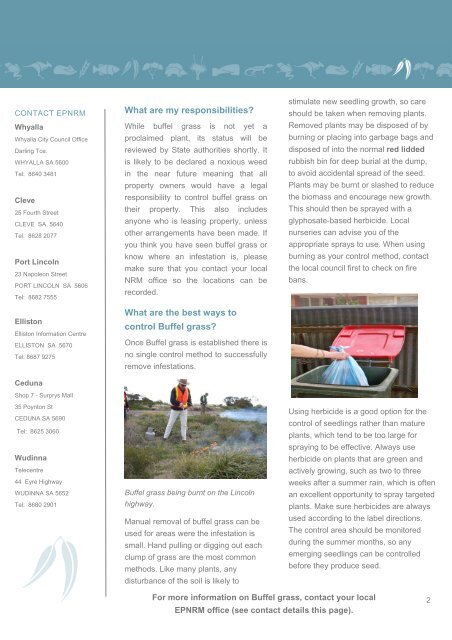Buffel grass - Eyre Peninsula Natural Resources Management ...
Buffel grass - Eyre Peninsula Natural Resources Management ...
Buffel grass - Eyre Peninsula Natural Resources Management ...
Create successful ePaper yourself
Turn your PDF publications into a flip-book with our unique Google optimized e-Paper software.
CONTACT EPNRM<br />
Whyalla<br />
Whyalla City Council Office<br />
Darling Tce.<br />
WHYALLA SA 5600<br />
Tel: 8640 3481<br />
Cleve<br />
25 Fourth Street<br />
CLEVE SA 5640<br />
Tel: 8628 2077<br />
Port Lincoln<br />
23 Napoleon Street<br />
PORT LINCOLN SA 5606<br />
Tel: 8682 7555<br />
Elliston<br />
Elliston Information Centre<br />
ELLISTON SA 5670<br />
Tel: 8687 9275<br />
Ceduna<br />
Shop 7 - Surprys Mall<br />
35 Poynton St<br />
CEDUNA SA 5690<br />
Tel: 8625 3060<br />
Wudinna<br />
Telecentre<br />
44 <strong>Eyre</strong> Highway<br />
WUDINNA SA 5652<br />
Tel: 8680 2901<br />
What are my responsibilities<br />
While buffel <strong>grass</strong> is not yet a<br />
proclaimed plant, its status will be<br />
reviewed by State authorities shortly. It<br />
is likely to be declared a noxious weed<br />
in the near future meaning that all<br />
property owners would have a legal<br />
responsibility to control buffel <strong>grass</strong> on<br />
their property. This also includes<br />
anyone who is leasing property, unless<br />
other arrangements have been made. If<br />
you think you have seen buffel <strong>grass</strong> or<br />
know where an infestation is, please<br />
make sure that you contact your local<br />
NRM office so the locations can be<br />
recorded.<br />
What are the best ways to<br />
control <strong>Buffel</strong> <strong>grass</strong><br />
Once <strong>Buffel</strong> <strong>grass</strong> is established there is<br />
no single control method to successfully<br />
remove infestations.<br />
<strong>Buffel</strong> <strong>grass</strong> being burnt on the Lincoln<br />
highway.<br />
Manual removal of buffel <strong>grass</strong> can be<br />
used for areas were the infestation is<br />
small. Hand pulling or digging out each<br />
clump of <strong>grass</strong> are the most common<br />
methods. Like many plants, any<br />
disturbance of the soil is likely to<br />
stimulate new seedling growth, so care<br />
should be taken when removing plants.<br />
Removed plants may be disposed of by<br />
burning or placing into garbage bags and<br />
disposed of into the normal red lidded<br />
rubbish bin for deep burial at the dump,<br />
to avoid accidental spread of the seed.<br />
Plants may be burnt or slashed to reduce<br />
the biomass and encourage new growth.<br />
This should then be sprayed with a<br />
glyphosate-based herbicide. Local<br />
nurseries can advise you of the<br />
appropriate sprays to use. When using<br />
burning as your control method, contact<br />
the local council first to check on fire<br />
bans.<br />
Using herbicide is a good option for the<br />
control of seedlings rather than mature<br />
plants, which tend to be too large for<br />
spraying to be effective. Always use<br />
herbicide on plants that are green and<br />
actively growing, such as two to three<br />
weeks after a summer rain, which is often<br />
an excellent opportunity to spray targeted<br />
plants. Make sure herbicides are always<br />
used according to the label directions.<br />
The control area should be monitored<br />
during the summer months, so any<br />
emerging seedlings can be controlled<br />
before they produce seed.<br />
For more information on <strong>Buffel</strong> <strong>grass</strong>, contact your local<br />
EPNRM office (see contact details this page).<br />
2
















